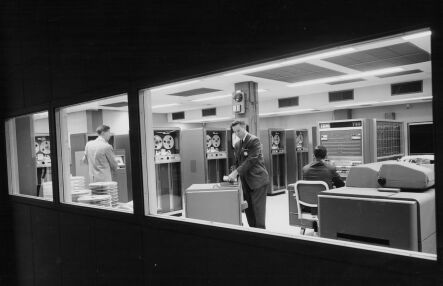
IBM 709
IBM had developed two lines of computer equipment, one for scientific computing and one for data processing. The 701 and 704 machines were for scientific computing; the 702 and 705 machines were for data processing. These two lines merged in the BM Type 709 Data Processing System and that was the system installed in the newly completed 25,000 square foot WDPC omputing center in October, 1958.
It was one of the most advanced systems commercially available in the world at that time. It had a central processing unit with a 32,768 word magnetic core memory, an 8,192 word magnetic drum memory, 20 magnetic tape drives, peripheral equipment to convert punch cards to magnetic tape and to print from magnetic tape, and EAM equipment to process punch cards centered around an IBM Type 407 Accounting Machine. It was a binary machine with a word length of 36 binary digits (equivalent to over 10 decimal digits).
The 709 could do fixed point operations at the rate of:
24 microsecond addition or subtraction (about 42,000 per second)
240 microsecond multiplication or division (about 4,000 per second)
24 microsecond logical operation (about 42,000 per second)
The 709 could do floating point operations at the rate of:
84 microsecond addition or subtraction (about 12,000 per second)
216 microsecond division (about 4,500 per second)
204 microsecond multiplictions (about 5,000 per second)
The primary programming language was FORTRAN II (FORmula TRANslator) . It was a compiler language in which users wrote their coding statements that were then compiled into a machine language program (the object program) for processing by the computer. FORTRAN is a progamming language that still survives and in use today.
The punch card was the primary medium for data and programs. Users sent bundles and boxes of cards to the Center where they were processed and printed reports returned.
IBM 709 PHOTO

Photo held in IBM Archives